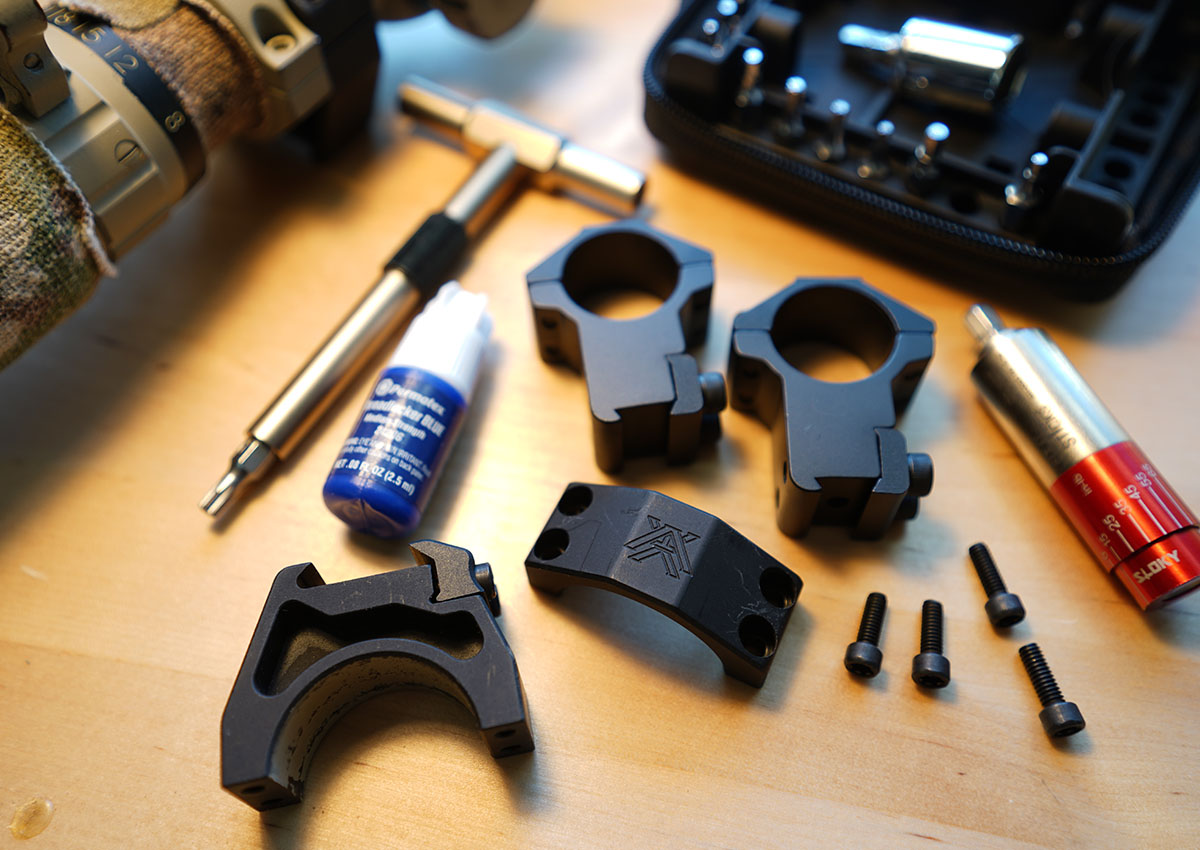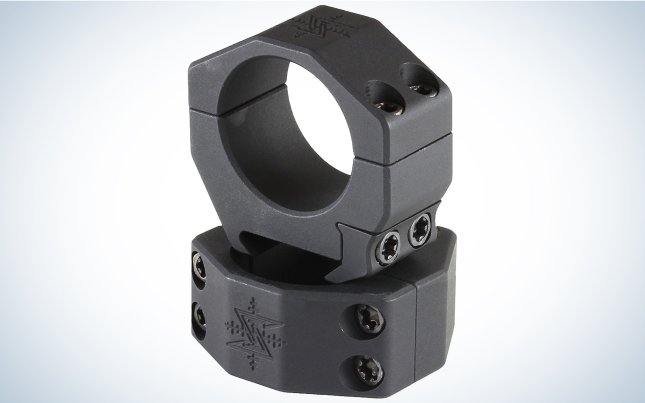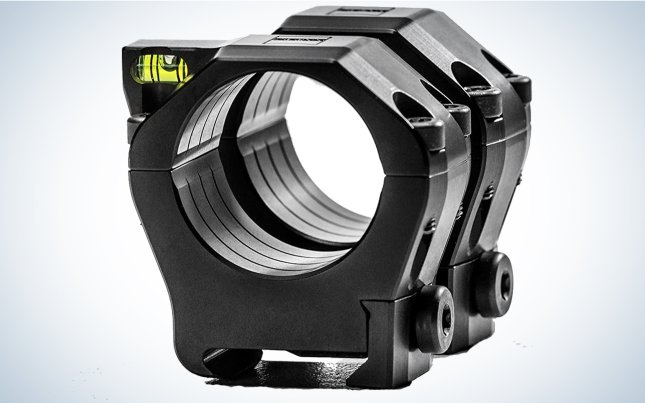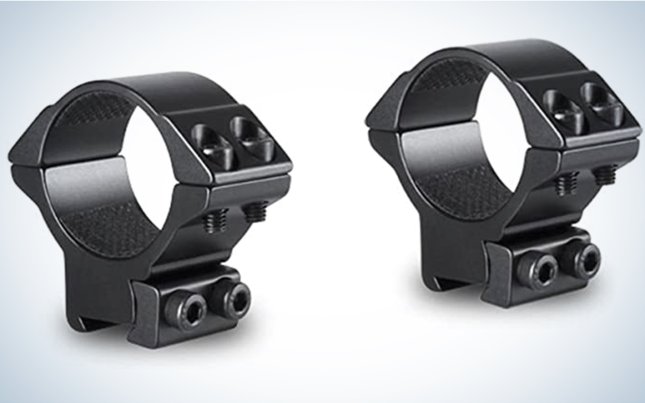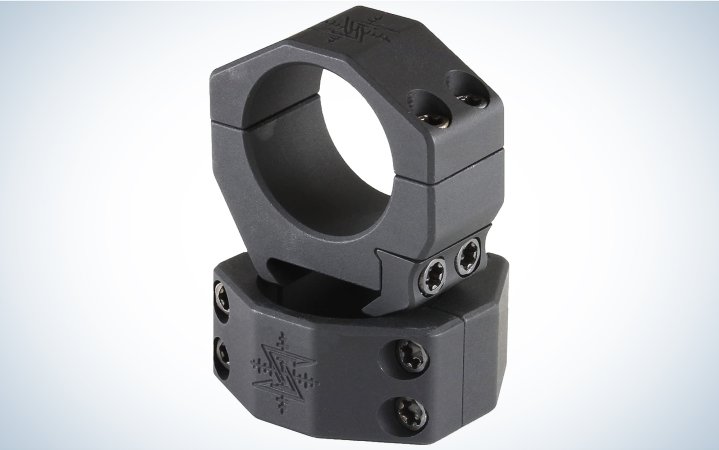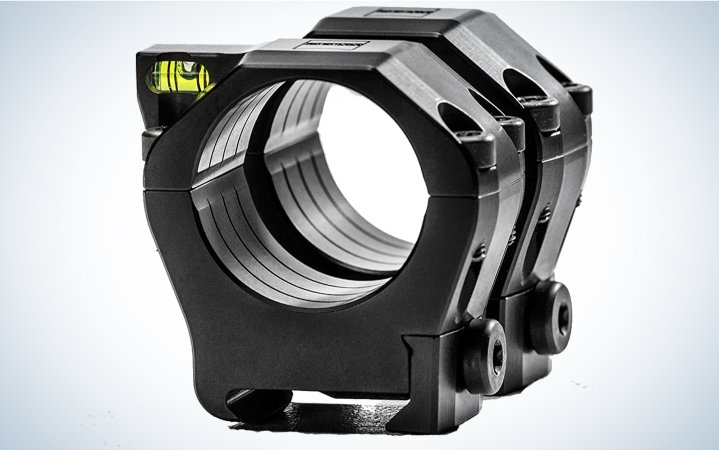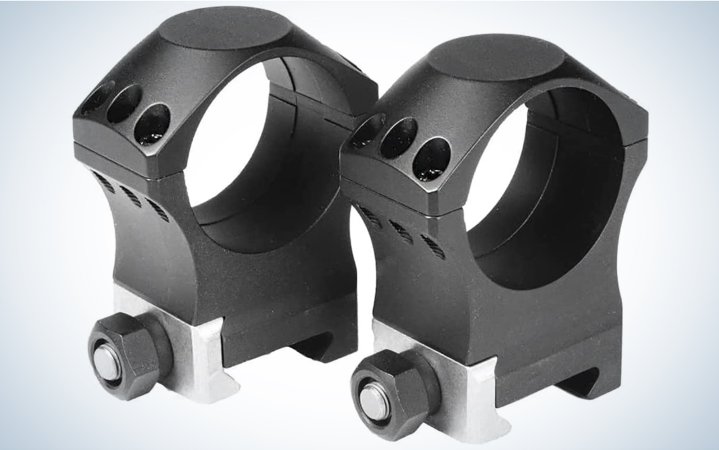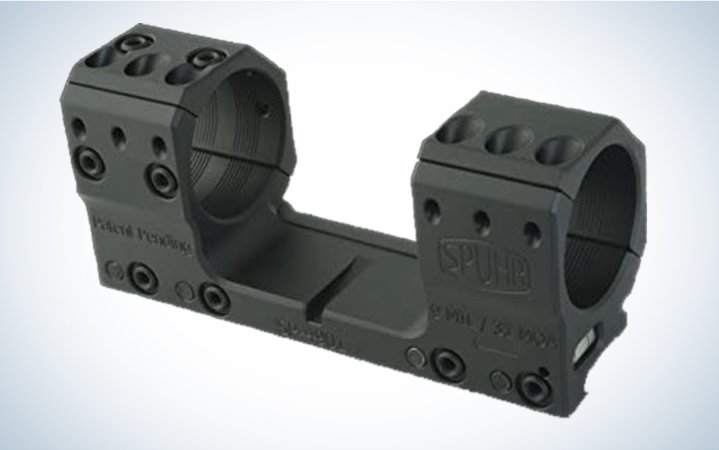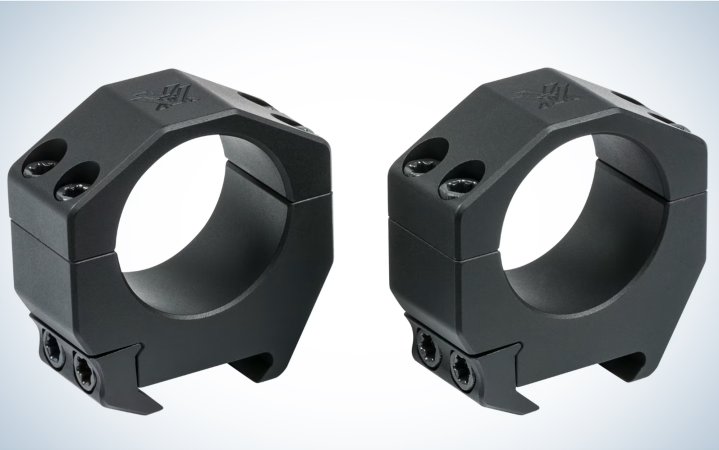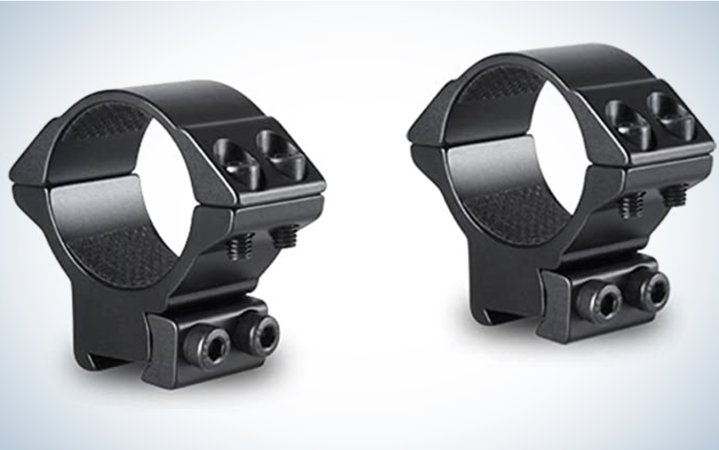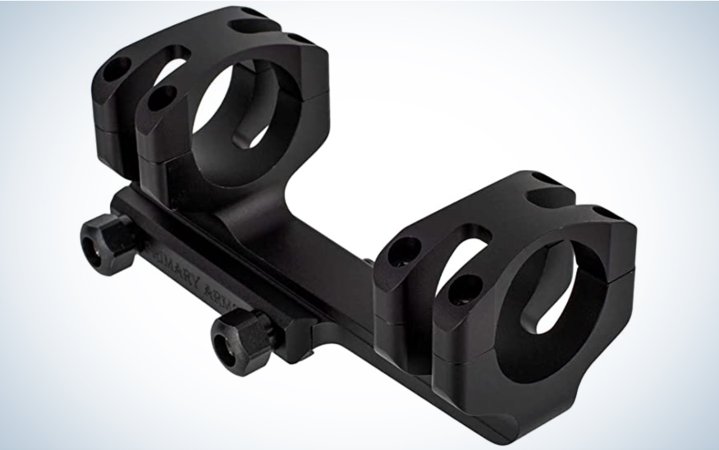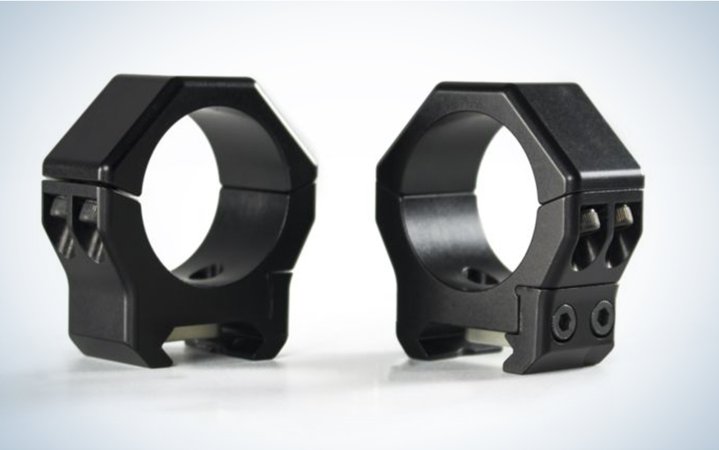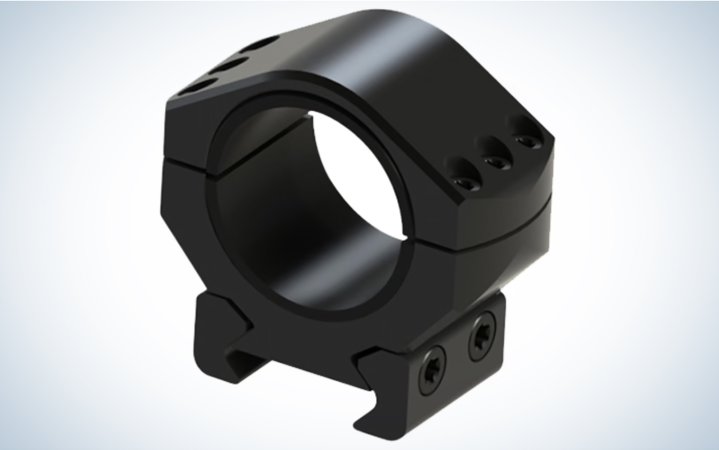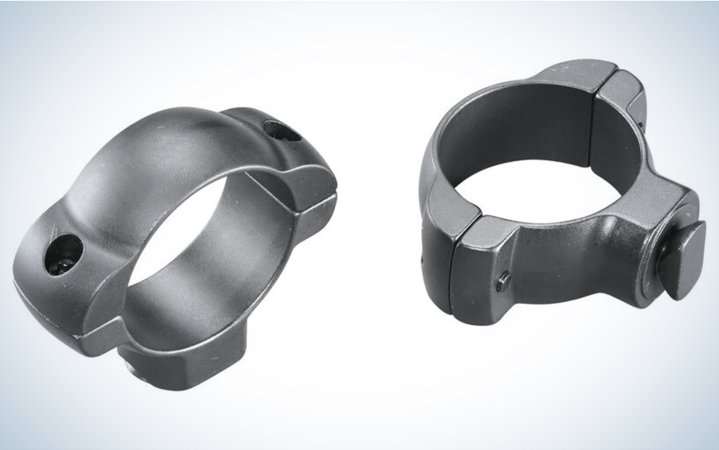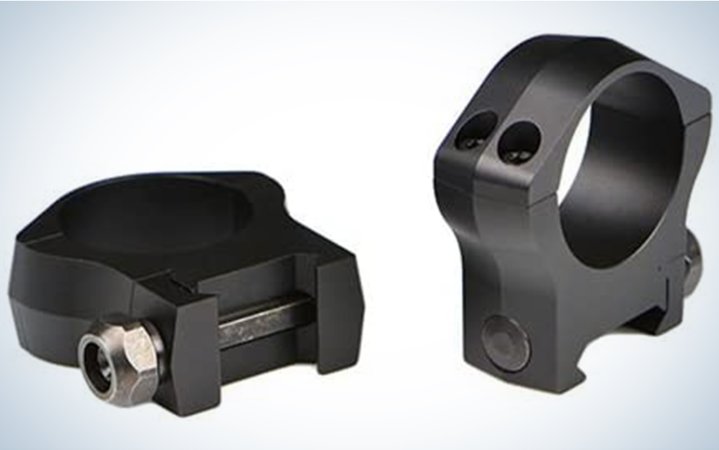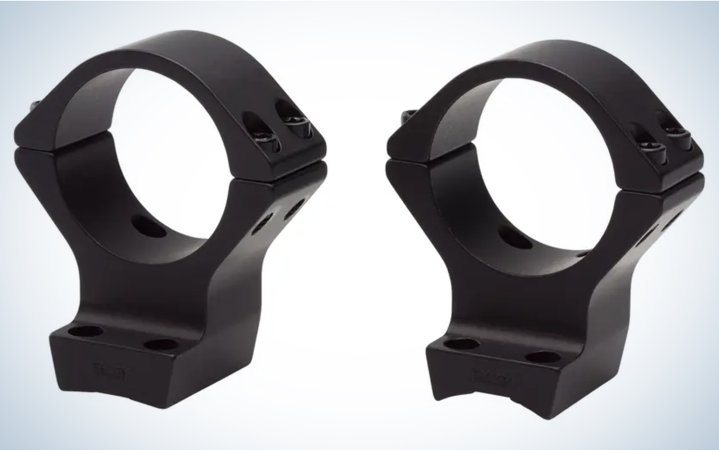We may earn revenue from the products available on this page and participate in affiliate programs. Learn More ›
I know what you’re thinking: Scope rings are pretty much the same. Oh, how wrong you are. The wrong rings can impede your accuracy, no matter how consistently your rifle shoots. Their one job is to keep your scope securely fastened to the top of your rifle, but they can work loose over time or fail to hold your zero. Here I review the best scope rings on the market, and help you find your ultimate rifle and optic combination.
- Best Overall: Seekins Precision Scope Rings
- Best for Hunting: Zeiss Ultralight Precision Rings
- Best Lightweight: Nightforce X-Treme Duty Ultralite Rings
- Best for Long Range Rifles: Sphur Unimount
- Best Budget Long Range: Vortex Precision Matched Rings
- Best Budget: Hawke Match Ring Mounts
- Best Budget Cantilever: Primary Arms GLx Cantilevered Scope Mount
- Best Custom-Fit: Triad Scope Mounts
- Best Adaptable: Burris XTR Signature Rings
- Best Leupold-Style Dovetail: Weaver Steel Dovetail Rings 30mm
- Warne Mountain Tech Rings
- Browning X-Bolt Integrated Scope Mount System
How I Tested the Best Scope Rings
I’ve used all the rings mentioned in this story over the course of 15 years of optics testing. Every year I mount up to three dozen scopes of different tube dimensions, styles, and objective-lens sizes on a wide variety of rifles. That experience has shown me which ring models are easy to mount and remove, which hold scopes without slippage or marring, and which rings are a waste of money. For this roundup, I selected a wide variety of models, brands, and types that represent most of the styles of rings on the market.
Best Scope Rings: Reviews & Recommendations
Best Overall: Seekins Precision Scope Rings
Pros
- Snag-free mounting design
- Liberal clamping surface
- Extremely strong T-25 hardware
- Center recoil lug machined directly into ring bottom
- Simple, effective design
Cons
- At 0.8-inch wide, they’re fairly wide rings
Key Features
- Weight: 4.1 ounces (30mm medium height)
- Material: 7075-T6 aluminum
- T-25 Torx screws
- Tube Diameters: 1 inch, 30mm, 34mm, 35mm
- Available in low, medium, medium-high, high, extra-high, and MSR heights
- Built to 1913 Picatinny rail specs
These Seekins rings are a great combo of simple, strong, and precise design and reasonable cost. The 30mm size runs $149, which is a cool $100 less than Vortex’s top scope rings for a similar build.

A number of scope rings feature a flat cap half, a feature that’s essential for ensuring that the scope’s reticle is level with the rifle. The Seekins cap is among the biggest mesa in the business. Other positives include an anti-glare finish and a wide range of heights: low, medium, medium-high, high, extra-high, and AR height.
The build of the Precision Rings is among the best in the business. Seekins starts with 7075-T6 aluminum and serializes the pairs to exacting standards. The 0.8-inch clamping surface is wider than other models, and the smooth edges and radiuses make these rings snag-free, reducing hang-ups on drag bags and scabbards. Lastly, the center lug machined directly into the bottom of the base is milled to 1913 Picatinny specs that fit precisely into Pic slots with minimal clearance or movement.
Read Next: Best Rifle Scopes
Best for Hunting: Zeiss Ultralight Precision Rings
Pros
- Leveling bubble can be configured for left- or right-handed shooters
- Non-snagging build
- Ships with hard case
- All leading edges have micro-radiused machining to reduce glare
- Tube-facing grooves reduce slippage
- Extremely durable
Cons
- At over $200, fairly pricy
- Single T-25 screw clamps to rail
Key Features
- Weight: 4.4 ounces for 30mm medium rings
- Material: 7075-T6 aluminum with anodized finish
- Double T-15 Torx cap screws on cap
- Double T-25 Torx mounting screws
- Ships in handy case, includes Torx driver bits
- Tube Diameter: 30mm, 34mm, 36mm
- Available in low, medium, and high, X-high, and XX-high heights
- Integrated recoil lug
- Fits: 1913 Picatinny rail
This is simply the most reliable, precise, and elegant scope ring on the market, and is specifically designed for precision shooters. Starting with the flat cap surface for leveling down to the extremely precise screw and thread engagement to the built-in leveling bubble, these are easy to use and will hold even huge 34mm, 5-25×56 and larger scopes tightly and precisely.
The build has a low-profile stature with non-snagging hardware. Zeiss sends both T-15 and T-25 Torx bits for both the cap screws (T-15) and the cross-slot screws. Both are finished in black oxide for corrosion resistance and non-glare. The rings’ leading edges are further micro-radiused to create a non-marring surface.
The Ultralight Precision Rings bring a further, squishier, quality: They are beautiful to look at. Elegant in proportion and built to satisfy shooters with extremely high expectations of their gear. The gold standard in precision scope rings, the Zeiss Ultralight 1913 Mil-Std Rings are compact, built with premium components, and feature a built-in leveling bubble.
Best Lightweight: Nightforce X-Treme Duty Ultralite Rings
Pros
- Exceptional strength for its light weight
- Choice of 4- or 6-cap screw design
- Choice of six heights for 30mm or 4 heights for 34mm models
- Flat top on cap ring enables leveling
Cons
- Torque on jaw nut needs to be exact
- Sizing is confusing
Key Features
- Weight: 3.3 ounces for 30mm medium mount
- Material: 7075-T6 hard anodized aluminum and titanium crossbolts and jaws
- Double or triple T-15 Torx cap screws on cap
- Single ½ inch nut clamps to rail
- Tube Diameter: 30mm and 34mm
- Integrated recoil lugs
- Fits: M1913 Picatinny rail
Given the extensive machining and quality components, you’d think these top-end Nightforce rings would cost much more than the $170 that they typically retail for. Made with premium aluminum (the rings and bases) and titanium cross bolts and jaws, this is the lightweight rig you want for your ultralight mountain rifle and featherweight scope.
The build gives shooters all the strength of steel at half the weight, and for that reason the X-Treme Duty rings have become darlings of the mountain-rifle crowd that needs to minimize weight but maximize performance. While the standard 4-screw caps should provide all the clamping surface most shooters need, Nightforce offers the X-Treme Duty rings with a 6-screw cap that offers even more clamping surface for larger scopes.
Best for Long Range Rifles: Sphur Unimount
Pros
- Rugged
- Reliable
Cons
- Heavy
Key Features
- Weight: 8.4 ounces for 30mm medium rings
- Tube Diameters: 30mm, 34 mm, 35mm, 36mm, and 40mm
- Integrated level
- Available in low, medium, high, and MSR heights
- Available with built in tilt for added elevation
- Fits: Picatinny rails
If you want the most rock solid scope mount available, you want a Sphur Unimount. They are machined from a single piece of aluminum, so they are perfectly aligned. The integrated level is a nice added feature and is out of the way compared to other options. You can also add a host of accessories to the rings like red dots. They have a wide surface area to securely grip the scope and spread out the pressure of the torqued down rings. What you end up with is an unquestionable rugged scope mount that’s trusted by competitors and silent professionals alike.
According to a survey of top Precision Rifle Series and National Rifle League competitors, the overwhelming majority use Sphur mounts. You’ll also see them on some of the best sniper rifles. Sphur also makes lighter mounts for hunters that are worth checking out if you want a premium scope mount for your long range hunting rifle.
Best Budget Long Range: Vortex Precision Matched Rings
Pros
- Extremely precise machining
- Low-glare
- Anti-snag design
- Robust grade 8 fasteners
- Excellent warranty
- Good scope pressure geometry
Cons
- Price
- Overbuilt for some applications
Key Features
- Weight: 3.9 ounces for 30mm medium rings
- Material: 7075 aluminum
- 1/2 inch nut clamps to rail
- 4-screw design compatible with T-15 Torx
- Tube Diameter: 1-inch, 30mm, 34mm, 35mm, 40mm
- Objective Lens Diameter: 42mm, 50mm, 56mm
- Available in low, medium, high, and MSR heights
- Fits: Weaver-style bases and Picatinny rails
Vortex has done a nice job of delivering a wide range of scope rings at various price points and builds to match its wide line of rifle scopes. Note that this is the top of Vortex’s extensive scope ring line, with heights ranging of 0.87, 0.97, 1.26, and 1.45 inches.

The manufacturing process of these extremely precise rings will make your head spin. Tolerances are held to 0.0005 inches, and rings are then serialized and bead-blasted to reduce glare. The Precision Matched series uses T-25 Torx heads for good torquing and solid holds. And they’re amazingly light for their robust build. Mated with a Vortex Razor HD GenIII scope on a precision rifle, there is little excuse for missing even distant targets.

It’s hard to ignore the price of the Precision Matched line, though. They retail for around $240, or double the price of the very good Pro Series steel rings. Yet they are about $200 less than a Sphur Mount. Other Vortex mounting options to consider are their very good line of cantilever mounts and the entry-level Hunter line of rings.
Best Budget: Hawke Match Ring Mounts
Pros
- Simple design
- Edges are rounded to prevent snagging and scope damage
- Extremely affordable, around $30 for set of 30mm medium rings
- Cushioned tape prevents scope scratching and marring
Cons
- Tacky tape can leave residue on scope tube
- Hex screws not as precise as Torx
Key Features
- Weight: 3.1 ounces for 30mm medium rings
- Material: Anodized aluminum
- Double hex screws on cap and rail mount
- Internal cushion tape prevents marring on scope tube
- Tube Diameter: 1-inch and 30mm
- Available in low, medium, and high heights
- Fits: Weaver rails
Very affordably priced, Hawke has a scope ring product line for just about every budget and rifle build. While this is not a hyper-precise build, Hawke doesn’t intend it to be. Instead, it’s an accessible priced product (retailing for under $30) that is part of the brand’s extensive lineup of optics mounts. The 1-piece cantilevered match line retails for around $40, the 2- and 1-piece Precision Steel ring line sells for around $45-50 with lever versions costing around $74. You can spend up to $150 for Hawke’s Professional Steel Ring mounts, and the Tactical Ring Mounts use 3 cap screws and a beefier build.
Best Budget Cantilever: Primary Arms GLx Cantilevered Scope Mount
Pros
- Extremely fast to mount and remove
- 20 MOA elevation ideal for long-range applications
- Pushes optics over 2 inches forward for optimal eye relief
- Open cap style provides abundant contact with scope tube
Cons
- 20MOA base can frustrate bore-sighting
- Cantilever design not ideal with large objective scopes
Key Features
- Weight: 6.7 ounces for 30mm medium mount
- Material: 6061-T6 anodized aluminum
- Double T-15 Torx cap screws on cap
- Double ½ inch nuts clamp to rail
- Tube Diameter: 30mm and 34mm
- Two integrated recoil lugs
- Fits: M1913 Picatinny rail
Primary Arms sells a lot of mounting hardware from other brands, but this mount, along with the PLx line, are made in-house and feature a ton of value. The cantilever mount is machined from 6061-T6 aluminum and is optimized for use on AR platforms. With built-in 20MOA of elevation, the model can extend the adjustment range of scopes to enable them to reach out over greater distance. The design also pushes optics forward to ensure shooters get greater eye relief, especially at higher scope magnifications.
The skeletonized 4-screw cap rings reduce weight without sacrificing strength, and the ½-inch “tactical thumbscrews” are easy to quickly mount and remove. It’s a simple, no-nonsense one-piece mount with 20 MOA of elevation built into the base: perfect for AR platforms.
Best Custom-Fit: Triad Scope Mounts
Pros
- Three-key rail-adjustment system fits wide variety of receivers
- Under-angled screw design eliminates corrosion
- Under-cut wedge design enhances accuracy
- Extremely lightweight
Cons
- Under-angled screw design can be hard to mount
- Mounting keys can cause confusion
Key Features
- Weight: 3.0 ounces for 30mm medium mount
- Material: 6061-T6 aircraft-grade aluminum
- Double hex cap screws
- Double hex jaw screws clamp to rail
- Tube Diameter: 30mm and 34mm
- Three recoil lugs
- Fits: Weaver-style and Picatinny rails
These are one of the best scope rings because they ship with three different rail-mounting keys to fit different tolerances of receiver rails. These innovative rings is that the cap screws don’t deploy from the top, as most do. Instead, they are screwed upward from the underside of the ring. The idea is that by keeping the screw head hidden, it won’t gather as much corrosive water and other materials, thereby extending the life of the ring.
The Triad ships with six metal slugs. These are keys that fit different tolerances of receiver rail, thereby giving customers more capability for mounting to different rifles. The inserts have tolerances that range from nominal to +.0035 and -.0035, ensuring a precise fit with Weaver-style rails but also European rails and standard Picatinny rails.
Best Adaptable: Burris XTR Signature Rings
Pros
- Each ring set includes MOA-based inserts
- Three cap-screw design is secure
- Ships in premium hard case
- Double jaw-screw design is precise
Cons
- Inserts are hard to align
- Easy to over-tighten
Key Features
- Weight: 5.5 ounces for 30mm medium mount
- Material: Aluminum rings with steel screw clamps
- Triple hex cap screws
- Double hex jaw screws clamp to rail
- Tube Diameter: 1-inch, 30mm and 34mm
- Objective Lens Diameter: 44mm, 50mm, 56mm
- Fits: Weaver-style and Picatinny rails
Burris has provided shooters with a solution to various elevations and shims with its Signature Rings. These rings have inserts that can re-center your scope and give scopes additional elevation range. Priced in the $120-180 range, depending on height and diameter, the most remarkable detail of these kits is the shims.
Burris calls this the Pos-Align Insert system that allows users to center scopes and ensure maximum concentricity inside the rings. The shims also allow for natural elevation, +/- 5 MOA, +/- 10 MOA and +/- 20 MOA. Used in tandem, those shims make it possible for a shooter to make 0, 5, 10, 15, 20, 25, 30, or even 40 MOA of cant inside the scope mount. The shims also enable perfect centering and maximum scope-to-ring contact.
Best Leupold-Style Dovetail: Weaver Steel Dovetail Rings 30mm
Pros
- Fits standard dovetail bases
- Simple single-cap-screw design
- Mounting system can be adjusted for windage
Cons
- Old-style mounting system
- Single cap-screw design not especially precise
Key Features
- Weight: 6.5 ounces for 30mm medium mount
- Material: Steel rings
- Single Torx cap screw
- Dovetail base mount
- Tube Diameter: 1-inch, 30mm
- Fits: Leupold-style dovetail bases
While you won’t see a ton of Leupold-style dovetail rings and bases on the market these days, some of our favorite rifles have this system, and Weaver has a robust, strong, and stylish solution for mounting optics. At about $35, it’s an affordable system, and offers some capabilities that are hard to impossible to achieve with Weaver-style slot systems: the rear base can be feathered for precise windage control, and the dovetail system also allows users to true scopes that may have untrue tube geometry.
Warne Mountain Tech Rings
Pros
- High strength-to-weight ratio
- Simple design
- Mounting nut enables quick swaps
- Wide versatility
Cons
- Nut can work loose
- Incompatible with Leupold-style bases
Key Features
- Weight: 3.9 ounces for 30mm medium rings
- Material: 7075 aluminum
- 1/2 inch nut clamps to rail
- 4-screw design compatible with T-15 Torx
- Tube Diameters: 1-inch, 30mm, 34mm, 35mm, 40mm
- Available in low, medium, high, and MSR heights
- Fits: Weaver-style bases and Picatinny rails
Warne’s Mountain Tech rings are like a good hunting buddy: they are reliable, hard-working, and don’t call attention to themselves. That’s why I call them middle-of-the-roaders. They have all the elements you want in a do-everything scope ring. They’re manufactured from lightweight, mil-spec aluminum billets, they have corrosion-resistant stainless steel crossbolts, and their ½-inch nut makes them easy to deploy and remove.
Warne deserves a big shout-out for continually evolving its scope ring line. The Oregon-based company was one of the first to offer after-market rings that fit a wide variety of firearm actions, but their early models were ponderously heavy. The company has moved into precision CNC work, and offers a line of rings for just about every budget and rifle. The Warne Mountain Tech Rings are solid, simple, and reliable without being either too over-engineered or spendy.
Browning X-Bolt Integrated Scope Mount System
Pros
- Elegant one-piece design
- Design minimizes misalignment between base and rings
- Four-corner attachment aids alignment with receiver
- Available in gloss, matte blued, and Burnt Bronze Cerakote
Cons
- Integrated rings fit only X-Bolt rifles
- Two mounting-screw races located inside lower ring
Key Features
- Weight: 6.4 ounces for 30mm medium rings
- Material: 7000-series aluminum
- T-25 Torx screws tighten to rail
- 4-cap screw design compatible with T-15 Torx
- Tube Diameter: 1-inch, 30mm, 34mm,
- Available in low, medium, and high heights
- Fits: Attaches directly to receiver of X-Bolt rifles
An elegant one-piece design reduces weight and moving parts that can work loose over the lifetime of the mating of scope and rifle. There are only a few true one-piece base-and-ring designs on the market — Talley was the pioneer in this regard—but the Browning X-Bolt design is strong, elegant, and relatively inexpensive. Priced at just over $70, this product will screw directly to the receiver of X-Bolt rifles, and the widely spaced four-screw design — called the X-Lock system — is both strong and creates a sturdy foundation for the optic because the base is secured at each corner.
Things to Consider Before Buying the Best Scope Rings

The first thing to consider before buying a set of rifle scope rings is simple: does it fit your gun and your optic? That sounds overly basic, but you’d be surprised at the number of shooters who buy 1-inch rings for their 30mm scope and wonder why they don’t fit. Or who buy low rings for a scope that has a 50mm objective lens that bumps up against the barrel of the gun. Make sure the diameter of the scope rings matches your scope’s tube size, and ensure that the ring’s height is compatible with the scope’s objective bell. You want an optic to clear your barrel, but not by so much that you have to raise your head in order to look through it.
Second, consider your shooting purpose. If you’re mounting a precision scope on a precision rifle, you want to use precision scope rings, hardware that’s been precisely milled and then matched to ensure concentricity and tight tolerances. If you’re mounting a $30 scope on a $150 rimfire, you can probably get away with rings that were manufactured with a little less precision.
Lastly, consider how the rings will mate up with bases. Many modern rifles have receiver slots that are designed to mate up with rings that have recoil lugs of the same size. But make sure they match. Many 1913 Picatinny rail lugs won’t fit Weaver slots, and Weaver lugs are often too sloppy to fit Pic rails.
FAQs
Sometimes called dovetail-style mounts, the Leupold style features an oblong key on the bottom end of the rings that fits a similar-shaped receptacle on the receiver. To mate the two, you swivel the ring into the base, and then make sure it’s in line with the bore and with the other ring. Weaver-style bases are simple slots. The ring has a recoil lug machined (or sometimes it’s a separate metal slug) into the bottom that mates with the slot in the base. The Weaver style is more universal, and because it’s machined at a right angle to the receiver, it should be more accurate and less prone to user error. While you can still find Leupold-style rings and bases on select rifles, it’s a system that’s rapidly being eclipsed by Weaver-style slot bases or Picatinny rails.
The question of the right number of screws that connect the top and bottom halves of scope rings is a matter of both personal preference and precision. I can fairly easily dismiss the 1-screw models. The single screw (one on each side) puts all the pressure on the very middle of the cap, and creates fairly flimsy tension on the scope. It’s a style that is best used on smaller scopes that aren’t intended for accuracy. Six-screw caps (three on each side) have additional pressure points, which should mean they create a tighter hold on the scope and minimize slippage, but it’s hard to get all three screws torqued to the same tension.
It seems like the middle screw tends to work loose quicker than the other two. I’m a fan of the 4-screw caps, especially for mil-spec rings, and it pays to buy rings that have good screw threads and heads. The T-15 Torx head is getting to be an industry standard, but the T-25 head is even better for torquing to the specific poundage recommended by both the scope and ring manufacturers.
The right torque value–or tightness–of rifle scope rings will depend a bit on the build of both the rings and the scope you’re mounting. Check with manufacturers for their recommendations, but generally most rings will hold securely at 15-20 inch-pounds. That’s enough torque to ensure that the cap screws won’t work loose, but which also won’t crush the aluminum scope tube. Note that the torque value for attaching rings to bases—these are the bottom screws that thread perpendicular to your gun’s barrel—are heavier than the cap screws. Many manufacturers recommend torqueing those base screws to 35-60 inch pounds. Adding a bit of Lok-Tite or other thread-holding compound is a good idea to ensure screws don’t work loose.
Final Thoughts on the Best Scope Rings
Scope rings and mounts are often the last thing that shooters consider when selecting a rifle and optic. That’s too bad, because the best scope rings for your gun and optic can make all the difference in milking out the best performance of those two components. Similarly, poor rings can turn an otherwise straight-shooting rifle into a scattergun. It pays to shop for a wide variety of rings to see which specific models are right for your setup.
- Best Overall: Seekins Precision Scope Rings
- Best for Hunting: Zeiss Ultralight Precision Rings
- Best Lightweight: Nightforce X-Treme Duty Ultralite Rings
- Best for Long Range Rifles: Sphur Unimount
- Best Budget Long Range: Vortex Precision Matched Rings
- Best Budget: Hawke Match Ring Mounts
- Best Budget Cantilever: Primary Arms GLx Cantilevered Scope Mount
- Best Custom-Fit: Triad Scope Mounts
- Best Adaptable: Burris XTR Signature Rings
- Best Leupold-Style Dovetail: Weaver Steel Dovetail Rings 30mm
- Warne Mountain Tech Rings
- Browning X-Bolt Integrated Scope Mount System
